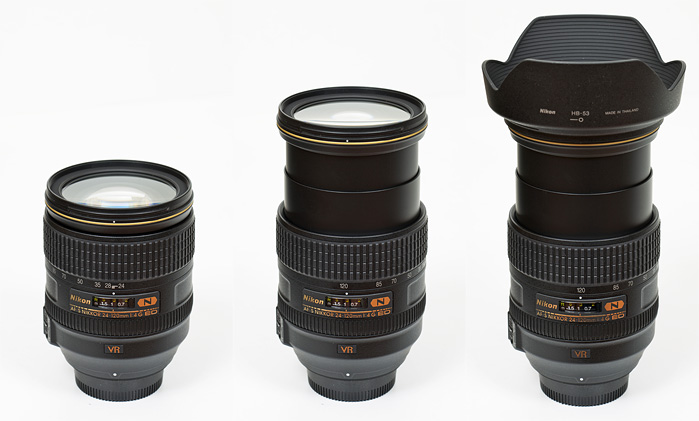|
Page 1 of 3

Review by Markus Stamm, published December 2010
Introduction
Ever since Nikon went full frame with their high end DSLRs, one lens has been really missing from their portfolio: a reasonably fast, high quality and stabilized standard zoom. There was (and still is) the AF-S 24-120/3.5-5.6 VR, of course, but it has a mixed reputation on FX and certainly doesn't qualify as a professional grade lens mechanically. Not only those who had switched from Canon to Nikon recently kept eyeing Canon's 24-105 L IS lens, it was pretty obvious that Nikon needed to offer a competitor in this focal range.
Announced and released around photokina 2010, this often requested lens is finally available. With a constant f/4 maximum aperture throughout the zoom range, which goes down to 24 mm at the short and up to 120 mm at the long end, it outspecs its main competition. Since it's primarily targeted at FX users, let's find out how it performs on our FX test camera.

Given a street price of around 1000 EUR/1100 USD at the time of this review (December 2010), the lens obviously targets the higher grade amateur and professional market and consequently the
build quality is rather high due to the use of magnesium alloy and high quality polycarbonate. There're seals for dust and moisture protection. Both the zoom and focus ring work smoothly and are well damped.
Unfortunately the focus ring shows a behaviour which we have seen in other recent Nikon lenses, too: there's a little play, not in the focus ring itself, but the coupling with the actual focus unit. When changing the focus direction, it takes a few millimeters of movement until the focus unit actually follows the focus ring. This can be annoying when trying to nail critical focus, for example in Live View.
In addition, the focus ring is rather thin and the travel path rather short. So, in summary, this lens is not much fun to focus manually.

The lens features a 77mm filter thread. Thanks to an internal focusing system (IF) the front element and filter thread do not rotate, so using a polarizer is no problem.
When zooming the lens extends towards the tele end of the focal range. Fully extended the lens shows no wobbling, even though it features a duocam design. At least on our review unit, there was no zoom creeping. The lens stayed in the chosen zoom setting even when pointed downwards vertically.
A petal shaped and unusually wide (but not very long) lens hood is supplied with the lens.
The Nikkor 24-120 VR is a G-type lens, so it does not offer an aperture ring
anymore. Thanks to an AF-S drive (Silent Wave Motor) AF operations are reasonably fast and
basically silent.
The lens features optical stabilization (VR II) which Nikon claims allows for up to 4 stops slower shutter speeds. Actual results will vary depending on the photographer, of course. In our field tests up to three stops longer shutter times were easily possible (given a reasonably steady subject). Typical for most high end VR lenses, the 24-120/4 VR offers a switch to chose between "Normal" and "Active" VR operation.
| Specifications |
|---|
| Optical construction | 17 elements in 13 groups inc. 2x ED and 3x aspherical elements and 1x element with Nano Crystal Coat |
| Number of aperture blades | 9 (rounded) |
| min. focus distance | 0.45 m (max. magnification ratio 1:4.2) |
| Dimensions | 84 x 103.5 mm |
| Weight | 710 g |
| Filter size | 77 mm, non-rotating |
| Hood | HB-53, petal-shaped, bayonet mount, included |
| Other features | sealing, silent-wave AF motor, VR II optical stabilization |
|